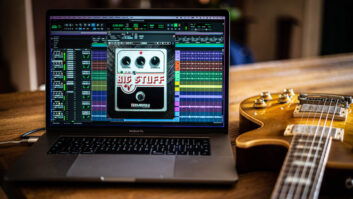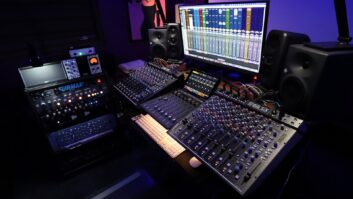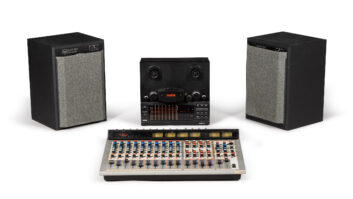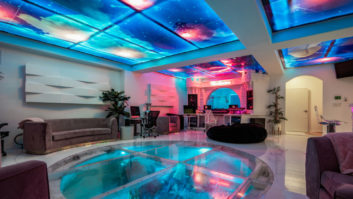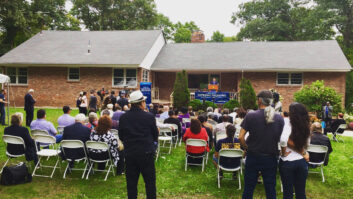
Bristol, TN & VA (September 11, 2020)—Former live sound engineer Clint Holley, a recording aficionado and owner of Well Made Music, a disk cutting facility in Cleveland, OH, is a huge fan of country music. So when he went in search of a new business venture, he naturally went to Bristol, known as the birthplace of country music. The U.S. Congress even passed a resolution to that effect in 1998.
In 1927, Ralph Peer, a record producer with the Victor Talking Machine Company, recorded 76 songs with 19 solo artists or groups over the course of 12 days in an effort that became known as the Bristol Sessions. The series of sessions, which included the first commercial recordings by Jimmie Rodgers and the Carter Family, is often considered the “Big Bang” of modern country music.
“My wife and I found an amazing historic building that is 500 feet from where the Carter Family and Jimmie Rodgers recorded their first sides,” says Holley, who established Well Made Music 10 years ago. Think of a record label and Holley’s company has likely cut dozens if not hundreds of projects for them over the past decade.

He and his wife had been looking to make some changes, says Holley, when they spotted the location on a trip through the region. The building, which they purchased in 2016, predates the Bristol Sessions and sits barely 300 feet from State Street, which splits downtown Bristol—the north side is Virginia, the south side, Tennessee.
The new venture, which they named the Earnest Tube as a play on the name of country music pioneer Ernest Tubb, had a simple concept. Holley and business partner Dave Polster, an audio engineer who joined Well Made Music in 2014, had hit on the idea of a direct-to-lacquer recording studio. “When you’re a disk-cutting engineer, you don’t hang out with the artist,” says Holley. “And we had this desire to get back in the studio and work with artists because we really enjoy that. Our mission statement was to re-create the essence of how people recorded in 1927—but bring modern thinking to it.”
They did a total teardown of the interior, creating a single space on the first floor with an open plan control room outfitted with a compact ’80s-era Sony/MCI desk. While Holley minds the Rek- O-Kut Imperial lathe, which is fitted with a mono Grampian cutting head, Polster handles engineering duties. Studio glass and doors would only get in the way, says Holley. “When you’re just recording a mono signal, you’re mixing on the fly and moving people around to create the mix. So we really wanted to have that open communication with people.”
Sessions are recorded in mono directly to the cutting lathe, usually through a single microphone but using more if necessary. “We talk to the artist before the session and ask if they’re looking for something more modern. We tailor according to those conversations.”
A Voice-O-Graph Blast from the Past
In addition to the mic preamps in the desk, a UA 610 and an old Collins preamp are available. “We also have the front end from an old [Berlant] Concertone tape recorder. Whatever works,” he says.
“We’ve been working with a lot of ribbon mics,” continues Holley, who has found some gems at flea markets and garage sales. The collection includes vintage RCA 77DX and 74B Junior Velocity models, as well as newer ribbons from Cascade, Nady and Samson, a Michael Joly-modified Oktava, and Electro-Voice EV 664 and 666 dynamic mics.
There’s even an old carbon mic, which Holley bought from the guy who sold him the lathe. “We also got the original preamp, a little wooden box with one knob on it. The Bristol Sessions were recorded on a carbon mic, so we’re excited to try that.”
Clients walk away with a lacquer of their session, but there is a modern twist. “We split the signal and send a clean signal to Pro Tools as a safety copy. We also transcribe the disk that we cut right after the take into the digital realm, so people have a copy of that to use in modern media and distribution. We really wanted to bring the whole experience into the modern age and give people that same thrill, but then have something usable in their hands when they walk out. We’ve seen people cutting on plastic and we wanted to offer something that was a real step up from that,” he says.
How people prepare for their direct-to-lacquer experience varies. “Some people get super prepared, some people get super anxious, some people get drunk and come in and do it. Our friend Tim Easton came over from Nashville and recorded an album in eight hours, Paco and the Melodic Polaroids. It’s amazing. It really sounds good,” he reports.
Leesta Vall’s Fast-Paced Lathe
The second floor was turned into a cozy singer-songwriter venue when the Earnest Tube launched but has been shuttered during the COVID-19 pandemic. “We’ve pivoted to a livestreaming model,” Holley says. They host performers in the first-floor space, which allows social distancing for up to four musicians. “We look at it as a cross between a recording session and a live show. We use floor monitors for the band, but no P.A. system; it goes straight to the livestream,” via OBS, Open Broadcast Software.
Since the Rek-O-Kut lathe is so portable, Holley used it on a podcast series for Ohio arts organization Roots of American Music. The podcasts featured music recorded in historical spaces and interviews with experts about the people associated with those locations, which included cartoonist R. Crumb’s old office and the home of abolitionist John Rankin of the Underground Railroad. “John and Alan Lomax used a machine similar to that before tape machines came in, when they were doing field recordings in the early part of the 20th century,” says Holley.
“We also have a big Presto lathe that can take 16-inch transcription disks. And we’ve relocated one of our two Neumann VMS-70 lathes, so now we can do disk mastering in both Cleveland and Bristol.”
The Earnest Tube • www.theearnesttube.com
Well Made Music • www.wellmademusic.net
